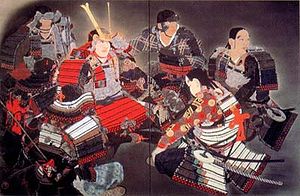- Seison Maeda
-
Maeda Seison 
Maeda SeisonBirth name Maeda Renzō Born January 27, 1885
Nakatsugawa, Gifu, JapanDied October 29, 1977 (aged 92)
Kamakura, Kanagawa, JapanNationality Japanese Field Painter Movement Nihonga Works Dokutsu no Yoritomo Awards Order of Culture In this Japanese name, the family name is "Maeda".Seison Maeda (前田 青邨 Maeda Seison, January 27, 1885 - October 29, 1977) was the pseudonym of a nihonga painter in Taishō and Shōwa period Japan. His real name was Maeda Renzō. He is considered one of the greatest contemporary Japanese painters, and one of the founders of the Nihonga movement.
Biography
Maeda was born in what is now Nakatsugawa city, Gifu Prefecture in 1885. His mother died when he was 13, and he moved to Hongō in Tokyo with his father. In 1901, through the introduction of Ozaki Kōyō, Maeda enrolled at the art school headed by Kajita Hanko, from whom he received the name "Seison" in 1902. He met and befriended fellow student, Kobayashi Kokei, whose work influenced many of Maeda's early paintings.
Maeda was a member of the Kojikai artistic group from 1907, and of the Japan Fine Arts Academy (Teikoku Bijitsuin) from 1914. Under sponsorship of the Japan Fine Arts Academy, he visited Europe in 1922, touring Rome, Florence and Paris. Although he was greatly impressed by the frescoes of the Italian Renaissance, Maeda remained faithful to the traditional Yamato-e and Rimpa styles of Japanese painting, and came to be known for his watercolor paintings on historical themes, primarily portraiture. However, Maeda worked in a variety of genres, including still life and landscapes.
One of his most important works, Yoritomo in a cave, depicts medieval samurai leader Minamoto no Yoritomo hiding in a cave in Izu with seven of his trusted retainers after his defeat by the Heike clan at the Battle of Ishibashiyama. The work was completed in 1929, and is now on display at the Okura Shukokan museum owned by the Okura Hotels in Tokyo. It was also the subject of a postage stamp issued by the Japanese government in 1982, as part of a series honoring Japanese modern art.
In 1944, Maeda was appointed as an official court painter to the Imperial Household Agency, and taught painting to Empress Kojun.
In 1946, Maeda became an official judge of the annual Japan Arts Exhibitions (Nitten). He was also a professor at the Tokyo National University of Fine Arts and Music from 1950 until his retirement in 1959.
Maeda was awarded the Order of Culture in 1955. In 1967, he was selected to assist in the restoration work on the frescos of the Kondo Hall of the temple of Horyu-ji in Nara. In 1970, his work was selected to decorate one of the halls of the new Imperial Palace. In 1972, despite his advanced years, he was selected as the person most appropriate to assist in the restoration and preservation work of the ancient frescos in the Takamatsuzuka tumulus.
Yoritomo in a Cave (洞窟の頼朝 Dokutsu no Yoritomo) 
Artist Maeda Seison Year 1929 Type Nihonga Dimensions 190.5 cm × 269.9 cm (75.0 in × 106.3 in) Location Okura Shukokan, Tokyo After Maeda's home was destroyed by the firebombing of Tokyo during World War II, Maeda relocated to Kamakura, where he lived within sight of Kita-Kamakura Station from 1945 until his death. His grave is a very distinctive 13-story white stone pagoda at the temple of Tokei-ji in Kamakura.
External links
References
- Conant, Ellen P., Rimer, J. Thomas, Owyoung, Stephen. Nihonga: Transcending the Past : Japanese-Style Painting, 1868-1968. Weatherhill (1996). ISBN 0-8348-0363-1
- Mason, Penelope. History of Japanese Art. Prentice Hall (2004). ISBN 0-13-117602-1
Categories:- Japanese painters
- People from Gifu Prefecture
- 1885 births
- 1977 deaths
- Court painters
Wikimedia Foundation. 2010.
